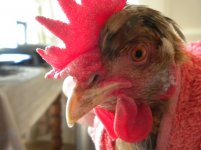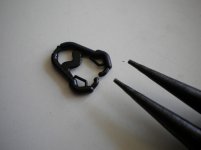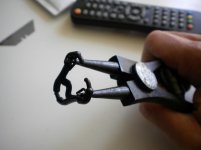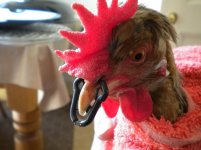chrismahon
Well-known member
Feather pecking and cannibalism in caged birds in too small a space is routine. Beak bits consisting of a metal or plastic ring are usually used on pheasants. De-beaked pheasants are not what the paying shooter expects. Chickens are usually de-beaked but birds for the public, who wouldn't buy de-beaked chickens are either reared with enough space or fitted with beak bits which are removed before sale.
Conventional beak bits I would describe as cruel. They are a simple ring crimped into the nasal holes. They don't fit in any way comfortably and prevent the beak from closing in a very crude manner. They obstruct normal movement of the tongue and I wouldn't dream of fitting them to a chicken. The intention is to prevent closure to pull out feathers or flesh, but they don't eliminate pecking.
Domestic keepers do encounter feather pecking. It is usually tacked by spraying the poor victim with a smelly sticky compound to discourage the attacker. Problem is the poor victim gets a beak full of the foul tasting stuff every time they try to preen. The attacker just picks on another better tasting victim.
We used to identify the attacker, rather than the victim, and remove them for a period. This worked on occasions, but we have culled good birds for persistent cannibalism. Wish we had known about Bumpa beak bits earlier!!
Bumpa beak bits are very carefully designed to fit with minimal discomfort but prevent the beak closing tightly and importantly to stop aggressive pecking. In our experience the birds are used to them within a day and can eat and forage as normal. They are available mail order from Omlet, but don't bother asking them for any detailed information. All I got was "none of us would ever fit these to our chickens, so we can't help".
As an example I have photographed 'mad' Molly, a little Cream Legbar who is rather aggressive and likes eating feathers. Rest to follow when I have resized the photos again, as they are still 50% too big.
Conventional beak bits I would describe as cruel. They are a simple ring crimped into the nasal holes. They don't fit in any way comfortably and prevent the beak from closing in a very crude manner. They obstruct normal movement of the tongue and I wouldn't dream of fitting them to a chicken. The intention is to prevent closure to pull out feathers or flesh, but they don't eliminate pecking.
Domestic keepers do encounter feather pecking. It is usually tacked by spraying the poor victim with a smelly sticky compound to discourage the attacker. Problem is the poor victim gets a beak full of the foul tasting stuff every time they try to preen. The attacker just picks on another better tasting victim.
We used to identify the attacker, rather than the victim, and remove them for a period. This worked on occasions, but we have culled good birds for persistent cannibalism. Wish we had known about Bumpa beak bits earlier!!
Bumpa beak bits are very carefully designed to fit with minimal discomfort but prevent the beak closing tightly and importantly to stop aggressive pecking. In our experience the birds are used to them within a day and can eat and forage as normal. They are available mail order from Omlet, but don't bother asking them for any detailed information. All I got was "none of us would ever fit these to our chickens, so we can't help".
As an example I have photographed 'mad' Molly, a little Cream Legbar who is rather aggressive and likes eating feathers. Rest to follow when I have resized the photos again, as they are still 50% too big.




